Difference between revisions of "×elyhordeum montanense"
FNA>Volume Importer |
FNA>Volume Importer |
||
| Line 40: | Line 40: | ||
|publication year= | |publication year= | ||
|special status= | |special status= | ||
| − | |source xml=https://jpend@bitbucket.org/aafc-mbb/fna-data-curation.git/src/ | + | |source xml=https://jpend@bitbucket.org/aafc-mbb/fna-data-curation.git/src/f6b125a955440c0872999024f038d74684f65921/coarse_grained_fna_xml/V24/V24_413.xml |
|subfamily=Poaceae subfam. Pooideae | |subfamily=Poaceae subfam. Pooideae | ||
|tribe=Poaceae tribe Triticeae | |tribe=Poaceae tribe Triticeae | ||
Revision as of 20:15, 24 September 2019
Culms 60-100 cm. Sheaths glabrous; blades 5-8 mm wide, flat, lax. Inflorescences spikelike, 8-17 cm, nodding, with 3 spikelets per node. Spikelets with 1-4 florets, the lateral spikelets usually shortly pedicellate, with 1(2) sterile florets, the central spikelet sessile, with 2(3-4) sterile florets, the third and fourth florets rudimentary. Glumes 10-35 mm including the awns, slightly widened above the base; lowest lemma of central florets about 8 mm, glabrous towards the base, sparsely scabrous distally, awned, awns 15-25 mm, straight to slightly divergent at maturity. 2n = 28.
Distribution
N.Dak., Nebr., N.S., Que., Mont., Ill., Iowa, Oreg., S.Dak., Idaho, Wyo.
Discussion
×Elyhordeum montanense applies to hybrids between Elymus virginicus and Hordeum jubatum. It is often found in disturbed areas where both parental taxa grow. Short-awned specimens may reflect the involvement of E. submuticus rather than E. virginicus, two taxa that have sometimes been treated as conspecific.
Selected References
None.
